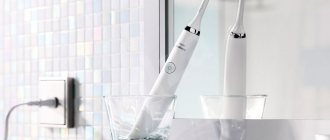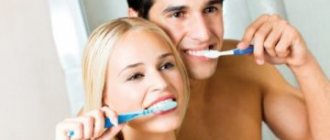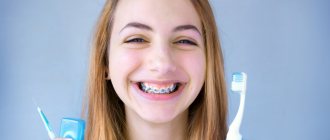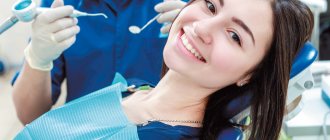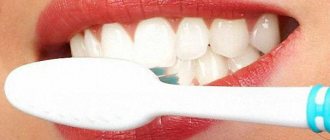03/13/2018 Editor
Mass production of electric toothbrushes began in the 60s of the last century. Modern devices are radically different from their predecessors, both in appearance and in the quality of cleaning tooth enamel. Despite the wide range of positive qualities and good reviews from dentists, not every person knows how to brush their teeth with an electric toothbrush. Let's look at this issue and learn about the main nuances of operating the device.
- 3.1 Precautions
Principle of operation
Unlike a conventional brush, the electric device operates from a power source. On sale you can find models with batteries or rechargeable batteries. A small built-in motor directs energy to the head, the bristles move and remove dirt. The intensity of rotation ensures effective cleaning of the tooth surface from plaque and other deposits. Many electric brushes can also enhance the effectiveness of toothpaste. This device can provide better and more effective oral hygiene. You can find reviews on the Internet on how to brush your teeth with an electric toothbrush. According to user reviews, this is a universal remedy that thoroughly cleanses teeth.
Philips Sonicare electric brushes: advantages and disadvantages
Philips products are recognized as reliable and high quality. In this case, we are talking not only about toothbrushes, but also about other equipment. Oral cleaning devices manufactured under the Philips Sonicare brand are no exception. Experts name the following advantages:
- allow you to quickly cleanse the oral cavity of germs and food debris;
- help eliminate plaque and prevent its formation;
- suitable for almost everyone, as they have no contraindications;
- equipped with many functions, sensors and indicators;
- Compatible with various attachments.
The only disadvantage of Philips Sonicare electric toothbrushes is their high price compared to other models. The attachments are also expensive. However, there is an opportunity to save money: the whole family can use one device, just each member must have their own nozzle. In addition, it offers a large selection of toothbrushes, among which you can find an affordable model.
What are the advantages of using
Cleaning with an electric special brush has a number of undeniable advantages:
- Quickly and efficiently removes various stains from enamel. Scientists conducted an experiment that proved that an electric brush removes plaque twice as well as a classic accessory. During the procedure, the user only needs to correctly guide the head with moving bristles. Dentists confirm that the use of such a device can prevent many dental diseases. The condition of the gums improves and plaque is quickly and effectively removed.
- The device cleans teeth effectively. The nozzle completely covers the tooth and cleans even hard-to-reach areas.
- Children love to brush their teeth with children's electric brushes. Using such a device, you will quickly teach your child the correct procedure.
- It will take about two to three minutes. When cleaning is performed using a standard accessory, part of the tooth surface is left unattended. The electric device is capable of completely covering the tooth. Some models have a built-in timer that will help you determine when it's time to move on to the next section.
According to user reviews, it is worth paying attention to various technical characteristics. It would also be a good idea to have a preliminary consultation with your doctor.
How to charge the brush
A new brush must be charged to its full capacity - the full charging time is indicated by the manufacturer in the instructions and can take up to 48 hours. Charging time depends on the battery capacity and other technical characteristics of the brush.
Many brushes have a charging indicator, which will help you understand the current state of the battery. If your brush has a nickel-metal hydride battery, you should charge it only after it is completely discharged. Brushes with lithium-ion batteries can be charged at any charge level.
When charging, the brush must be in a vertical position. It is best to charge the brush directly from the mains, without using intermediate devices such as a power bank or tablet - this is not only faster, but also safer.
Contraindications
Before you consider how to brush your teeth with an electric toothbrush, you need to know what contraindications exist for its use:
- Inflammatory processes in the gums.
- Increased abrasion of enamel.
- Presence of caries.
- Hypoplasia and other non-carious pathologies.
It is advisable to use an electric brush after prior consultation with your dentist. A competent doctor will give an objective assessment of the condition of the oral cavity and advise how to use the accessory. It is also not recommended to use an electric toothbrush for patients with various orthodontic appliances.
What characteristics of an electric brush need to be taken into account?
Before purchasing a brush, you should consult with your dentist, since the condition of your teeth and gums determines the requirements for the properties of the model you are using.
Bristle
The bristles should be made of synthetic materials, such as nylon. Natural fibers may have hollow parts where bacteria can accumulate over time. The stiffness of the bristles is selected by the doctor individually. Without his recommendation, you should not use brushes with hard bristles. Soft and very soft bristles are recommended for patients with sensitive enamel and gum problems, as well as for children. For the rest, medium-hard bristles are suitable. Particular attention should be paid to the tips of the villi. For more delicate care they are made rounded. Pointed bristles can scratch tooth enamel.
Battery or batteries
Battery-powered electric brushes lose power as their charge decreases. Therefore, the effectiveness of this tool may gradually decrease. In addition, when buying it, the user also acquires the need to constantly spend money on batteries. The battery allows you to control the charge level before each cleaning and does not require additional costs.
Handle and weight
It is better to choose a curved handle made of non-slip materials. The weight of the device should not strain your hand during the 3-5 minutes spent cleaning the entire oral cavity. It is especially worth paying attention to these characteristics when choosing a brush for children.
Number of nozzles
Several interchangeable cleaning heads allow you to use one electric brush for all family members. For example, buying a set of Glister™ Smart Sonic electric toothbrush and spare brush heads is cheaper than purchasing several separate accessories for the whole family.
Noise
The vibrations of electric brushes do not produce loud sounds. But those with sensitive hearing may experience discomfort from even a slight buzzing sound. In this case, you should opt for silent ultrasonic models.
Additional functions
The latest models of electric toothbrushes are equipped with features that allow you to improve the process of brushing your teeth. The most common among them:
- a timer that beeps when it is time to move to the next area in the oral cavity;
- a pressure sensor that warns when to reduce the pressure on the cleaning head;
- compatibility with a mobile application that allows you to evaluate the result of the procedure and configure the operating mode of the device.
This application was created for the Glister™ Smart Sonic electric brush. It:
- offers one of five operating modes depending on the condition of the teeth and eating habits;
- detects cleaning time;
- shows which area needs special attention.
How to properly brush your teeth with an electric toothbrush
Many people don't buy electric toothbrushes because they don't know how to brush their teeth with an electric toothbrush. The procedure must be performed correctly to obtain the desired effect. Before brushing, wet the bristles well with water, then apply a small amount of toothpaste. Please note: the bristles are usually angled to effectively clean the entire tooth surface. According to the rules, cleaning begins from the outside. It doesn’t matter which row you start the procedure from - from the top or from the bottom. When the brush is turned on, hold it slightly at an angle. Make smooth movements. A few seconds will be enough to clean one tooth. Make sure that the bristles cover each tooth unit. After cleaning the outside, we move on to the inside. Move gradually along the dentition, paying attention to each zone. Cleaning with an electric brush should last at least two minutes. Do not forget to wash the device after each procedure and wipe it dry with a towel.
What mistakes when brushing your teeth can cause tooth decay?
Here are a few common mistakes 8 Bad Brushing Habits to Break in 2021, which make brushing ineffective at best, and at worst a useless and even harmful activity.
You use the same toothbrush for more than 3–4 months
Worn and broken bristles cannot effectively remove plaque from teeth. The American Dental Association (ADA) recommends replacing your toothbrush with a new one every quarter.
You press too hard on the brush when brushing
You may feel like scrubbing harder will remove more bacteria and food debris. But that's not true. To properly “wash” the surface of the tooth, careful and even gentle movements are enough. But excessive assertiveness can damage the gums and even tooth enamel.
For the same reason, you should not use a brush with too stiff bristles.
You brush your teeth immediately after eating
Dentists recommend waiting at least 60 minutes. This is especially important if you have eaten something sour (for example, lemons, grapefruits) or drank soda. These products soften tooth enamel and brushing may be harmful.
If you're desperate to freshen your mouth immediately after eating, rinse it with water or chew gum.
You are storing your brush incorrectly
You should not keep the brush in a closed container: microbes actively multiply in such places, which you then carry into your mouth directly on the bristles. The best way to store your brush is in an upright position outdoors.
You do not follow proper teeth brushing technique
It is important to thoroughly and thoughtfully clean all dental surfaces, not just those that are easiest to reach. Remember why you are brushing your teeth. This procedure is not for show, its purpose is to keep teeth healthy and protect them from caries. So use your brush carefully.
Recommendations
A few useful tips will help enhance the cleaning effect:
- Use the accessory only with pastes. At the same time, you can use an irrigator and floss.
- Choose the right nozzle and paste. It is not recommended to use highly abrasive products with an electric brush.
- Be sure to consult your doctor. A competent dentist will help you choose the right hygiene products.
- There is no need to reduce or increase brushing time.
- Do not forget about timely replacement of nozzles.
- Try to keep the device clean.
Knowing how to properly brush your teeth with an electric toothbrush will make maintaining hygiene easy and simple.
Technology using thread (floss)
Dental floss is used to remove food debris and plaque in places where it is difficult for a standard brush to penetrate. Usually this is the interdental space, the distance between the orthodontic system, and the cervical area.
Before using this thread, you should correctly decide on its choice. Two types of floss are used for teeth:
- Nylon . Suitable for crowns with standard or wide interdental spaces. Removes plaque well.
- Teflon . Thinner than the first option, therefore it is recommended for people with a small gap between the crowns.
Floss will have a good effect only if used correctly:
- For cleaning you will need about 35 cm of thread. Measure it from the main coil and tear it off;
- wrap the ends of the thread around your index fingers;
- adjusting the tension of the floss with your thumbs, carefully pass it between the crowns;
- moving the thread up and down, clean the adjacent surfaces;
- after this, floss in the cervical area, covering the area under the gum;
- remove the floss by alternately pulling back and forth, while lifting;
- In the same way, carry out the procedure to remove deposits on the remaining teeth, using an untouched section of the floss. During this process, avoid sudden movements and excessive force to avoid cutting the gum tissue.
Below is a video with dentist tips on using floss:
Secrets of caring for braces
In order to efficiently clean the teeth and the space between the elements of the orthodontic structure, dentists recommend using not a regular brush, but a product with a V-shaped bristle or a mono-tuft model.
The procedure for removing plaque is also slightly different from regular cleaning:
- The brush is positioned at an angle of 45 degrees relative to the front surface of the tooth.
- With the help of forward and backward movements and slight pressure on the brush, the enamel is cleaned of the plaque covering it, both from the outside and from the inside.
- To clean the bracket, you need to perform a few light movements from the gum line to the cutting surface of the tooth and in the opposite direction. Strong pressure should be avoided to avoid damaging the locks.
- The cutting surface is cleaned by placing the brush perpendicular to the axis of the jaw row elements. Circular movements of the bristles, combined with slight pressure, will qualitatively remove small particles of food and pathogenic microflora.
To effectively remove plaque, dentists recommend working on each element of the row for at least 10 seconds.
Learn about hygiene with braces from the video.
Cleaning gums
Daily hygienic cleaning of the oral cavity at home prevents inflammation of soft tissues and dental diseases.
- The gums are cleaned when the device is turned off.
- A special attachment is used to clean and massage mucous membranes.
- The palate and tongue are processed.
- You need to act carefully so as not to damage the soft tissues and not cause receding gums.
- The movements should be light, the direction should be back and forth.
After cleaning, rinse your mouth with clean water or a special product. This will improve the condition of soft and hard tissues. People with sensitive and painful gums can use the miracle device no more than once every 7-10 days. Patients with oral problems should consult a dentist.
Ionic devices
The operating principle of the ionic brush is based not only on mechanical action, but also on changing the polarity of the teeth, due to which plaque is more effectively separated from the enamel.
The technology for cleaning the jaw row using this product is as follows:
- The hygienic procedure begins with the removal of plaque located on the surface of the tongue. Using gentle massage movements, you need to move from its base to the tip.
- The same delicate movements remove plaque from the gums and mucous membrane of the cheeks.
- Next, the brush is thoroughly rinsed under running water, after which a small amount of paste is applied to it.
- The procedure for cleaning the teeth is no different from those manipulations that are usually carried out when using a manual brush, with the difference that the intensity of movements may be lower.
To increase the effectiveness of using the brush, approximately once a month it is necessary to remove the attachment and clean the metal core.
In the video, a specialist explains how to use ionic toothbrushes correctly.
Brush position and pressure
Ultrasonic teeth cleaning is successfully carried out in a dental clinic. This professional procedure is performed using modern equipment. The effect is immediately noticeable. If you maintain it at home with an electric brush, then beautiful and white teeth are guaranteed. When cleaning, no special pressure is required to avoid damaging the enamel. Even devices with low power make 4 thousand revolutions in 60 seconds. You just need to choose the appropriate mode of operation of the device: from gentle to maximum.
New devices are usually equipped with sensors that monitor the degree of pressure. The design also includes a timer. It shows the time it takes to clean one segment. Smart brushes are convenient to use. Their head is designed taking into account the anatomical features of the dentofacial apparatus.
Applying the brush to the crowns along the line of the gum tissue, the head should be positioned at a 45-degree angle. In this case, the villi will touch the surface of the units and gum tissue. This position of the device will make cleaning more effective. The pressure on the brush should be minimal, since the vibration of the device creates additional pressure.
Irrigator
The use of an irrigator allows you to efficiently remove plaque from the gum pockets and interdental space, even with maximum crowding of incisors and molars.
To do this, you must follow the sequence of actions:
- An individual nozzle is installed in a special connector of the irrigator.
- The reservoir is filled with water at a temperature comfortable for the oral cavity or with a special rinse aid.
- If the device has several operating modes, the most suitable one is selected, taking into account the condition of the oral cavity.
- Teeth cleaning begins with the far molars. The device is positioned in the oral cavity so that the nozzle is directed at a right angle to the tooth, after which the power button is pressed.
- The space is treated in the following sequence: first the interdental space, then the gum line, then the rest of the molar. This manipulation is repeated with all elements of both jaws.
- After finishing using the irrigator, it must be turned off and the reservoir must be rinsed if a mouth rinse solution was poured into it.
Do not forget that while using the irrigator, water will flow out of the oral cavity, so the procedure must be performed in front of the sink.
Find out how to use the irrigator from the video.
Teeth whitening technique with activated carbon and effective recipes. Learn about the symptoms of oral cancer in this article.
Follow the link https://dr-zubov.ru/lechenie/bolezni-polosti-rta/gel-kamistad-instrukciya-po-primeneniyu.html if you are interested in instructions for using Kamistad ointment.
Mono-beam products
A mono-beam brush can be used not only by users of orthodontic structures, but also by everyone for the daily removal of plaque from the elements of the jaw row and gum pockets.
In order for the device to bring maximum benefit, when using it, you must adhere to the following sequence of operations:
- The head of the product is moistened with water, after which it is positioned at an angle of 45 degrees relative to the surface to be processed. It is advisable to start with the outermost molars, moving towards the central incisors.
- First, you need to clean the gum line, then treat the periodontal pocket and the remaining surface of the tooth, moving from the base to the cutting part. Movements should be sweeping or circular.
- After cleaning the front part of the tooth, the lingual part, the cutting surface and the space between adjacent molars are treated in the same way.
- The manipulations are repeated with each element of the jaw row. The duration of treatment of one tooth should not be less than 10 seconds.
The technique of cleaning with a mono-beam brush is presented in the video.
Chewing teeth
Manipulations on the chewing organs are carried out as carefully as possible with special attention. They are at high risk of pulpitis and caries.
- The surface of the molars is cleaned from all sides.
- When brushing, lightly press the brush to treat the space between the teeth.
- For high-quality treatment of the interdental space, a special thread is used. Dentists recommend flossing daily. You need to tear off 50 centimeters of thread and wrap the ends around your fingers. Using your thumbs to pull the center section taut, gently move the floss between the molars. Near the gum tissue, you need to floss around the surface of the chewing organ.
- The lateral part of the molar is wiped with thread. This will remove any bacteria buildup.
It is better to start the hygiene procedure with floss, and then work with a brush. Devices with 2D technology (forward-reciprocating movements) and 3D technology (with the addition of pulsation) perfectly process molars, removing pathological plaque.
Ninth step
Check if the toothbrush is dry, and if the answer to this question is yes, place it on a special stand. If the brush's charge is low, it is recommended to place it in the charging station in a timely manner so that the device is fully ready for use by the next time you brush your teeth. If the brush is set to recharge, we recommend that you monitor the charging process by turning off the gadget in a timely manner, because excessive charging installation time will not benefit the brush.
Flosses
Dental floss allows you to remove plaque and the smallest food debris from the minimal interdental space, which cannot be penetrated with a brush.
To achieve maximum results and prevent gum injury, you should follow these recommendations:
- With thoroughly washed and dried hands, remove about 30 cm of thread from the container and cut it using the built-in knife.
- The floss is wound around the index fingers of both hands so that the length of its free part does not exceed 5 cm.
- A section of floss formed between the fingers is inserted into the interdental space up to the gum line and gently lowered into the pocket, surrounding the neck of the tooth.
- With smooth sweeping movements, plaque is removed from under the gums, after which the thread is lifted with longitudinal movements to the cutting part.
- The used piece of thread is replaced with a new one, after which the manipulations are repeated in the next interdental space.
When flossing, it is important to use smooth movements to avoid accidental injury to the gum tissue.
Watch the video on how to use interdental floss.
